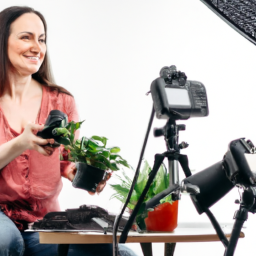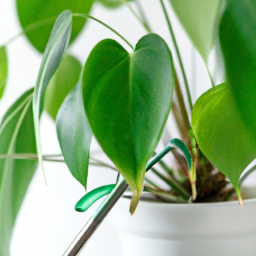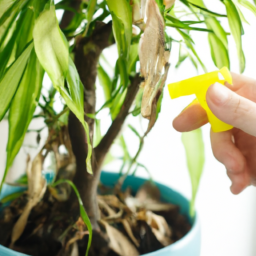
Identifying Common Indoor Plant Problems: A Guide for Troubleshooting
Indoor plants can bring life and beauty to any space, but sometimes they encounter problems that can hinder their growth and overall health. As an expert in indoor plant troubleshooting, I’m here to help you identify and solve common problems that you may encounter with your beloved green companions. By understanding the signs and symptoms, you’ll be able to take appropriate actions to ensure your indoor plants thrive.
1. Overwatering
Overwatering is one of the most common problems indoor plant owners face. It occurs when plants receive more water than they need, leading to root rot and other issues. The signs of overwatering include yellowing leaves, wilting, and a foul smell coming from the soil.
To solve this problem, you should adjust your watering routine. Allow the soil to dry out between waterings, and always check the moisture level by sticking your finger about an inch into the soil. If it feels dry, it’s time to water. Additionally, ensure that your pots have proper drainage to prevent water from pooling at the bottom.
If your plant has already developed root rot, you’ll need to take immediate action. Carefully remove the plant from its pot, trim off any affected roots, and repot it in fresh, well-draining soil. Avoid overwatering in the future to prevent the recurrence of this problem.
2. Insufficient Light
Another common problem faced by indoor plant owners is insufficient light. Plants need light to carry out photosynthesis, and without enough light, they may become weak, leggy, and have pale leaves.
To address this issue, you should assess the lighting conditions in your space. Identify which plants require bright, direct light and which can tolerate lower light levels. Place your plants accordingly, making sure they receive the appropriate amount of light for their specific needs. If natural light is limited, consider using artificial grow lights to supplement the lighting.
Remember to rotate your plants regularly to ensure all sides receive equal light exposure. If you notice your plant leaning towards a certain direction, it’s a sign that it’s not receiving enough light from that side.
3. Pest Infestations
Pests are a common nuisance for indoor plants. They can cause damage by feeding on leaves, stems, and roots, leading to stunted growth and an overall unhealthy appearance. Common indoor plant pests include aphids, spider mites, and fungus gnats.
To tackle pest infestations, it’s important to identify the specific pest affecting your plant. Inspect the leaves and stems for signs of pests, such as tiny insects, webs, or discoloration. Once identified, you can choose the appropriate method to control the infestation.
For small infestations, manually removing the pests by wiping them off with a damp cloth or using a gentle spray of water can be effective. For more severe cases, organic insecticidal soaps or neem oil can be used. Always follow the instructions on the product label and ensure proper ventilation when applying any chemicals to your plants.
Prevention is key to avoiding pest problems. Regularly inspect your plants for signs of pests, keep them clean, and avoid overwatering, as moist conditions can attract certain pests.
By understanding and addressing these common indoor plant problems, you’ll be equipped to troubleshoot and provide the necessary care for your plants. Remember to observe your plants closely, as early detection and intervention are crucial in maintaining their health and vitality. Happy indoor gardening!

Understanding the Causes of Indoor Plant Issues: Solutions and Tips
Indoor plants are a great way to bring nature into your home or office space. They not only add beauty and freshness to the environment but also provide numerous health benefits. However, like any living organism, indoor plants can face various issues that may hinder their growth and overall well-being. In this article, we will explore the common problems faced by indoor plants and provide practical solutions and tips to help troubleshoot these issues effectively.
1. Lack of Sufficient Light
One of the most common problems faced by indoor plants is the lack of sufficient light. Plants need light to carry out photosynthesis, which is essential for their growth and survival. When plants do not receive adequate light, they may exhibit symptoms such as pale leaves, stunted growth, and leaning towards the light source.
To solve this issue, consider the following tips:
1.1 Placement near windows:
Place your indoor plants near windows that receive ample sunlight. South-facing windows generally provide the brightest light, while east and west-facing windows offer moderate light. North-facing windows have the least amount of light, so choose plants that can tolerate low-light conditions for these areas.
1.2 Supplemental lighting:
If your indoor space lacks natural light, consider using artificial lighting options such as fluorescent or LED grow lights. These lights can provide the necessary light spectrum for plant growth. Place the lights close to the plants, ensuring they receive light for at least 12-16 hours a day.
1.3 Rotate plants:
Rotate your indoor plants every few weeks to ensure all sides receive adequate light. This prevents uneven growth and helps maintain the overall health of the plant.
2. Overwatering or Underwatering
Watering is a crucial aspect of indoor plant care, and improper watering practices can lead to various issues. Overwatering can cause root rot, while underwatering can result in wilting and dryness. It is essential to strike the right balance to ensure optimal plant health.
Follow these solutions and tips to avoid overwatering or underwatering:
2.1 Watering frequency:
Understand the water requirements of your specific indoor plant species. Some plants prefer moist soil, while others prefer slightly drier conditions. Check the moisture level of the soil regularly by inserting your finger about an inch deep. Water only when the top inch of soil feels dry to the touch.
2.2 Proper drainage:
Ensure that your plant containers have drainage holes to prevent water from accumulating at the bottom. Excess water should be able to drain freely to avoid waterlogged soil, which can lead to root rot.
2.3 Watering technique:
When watering, aim to moisten the entire root ball evenly. Avoid pouring water directly onto the leaves, as this can lead to fungal diseases. Use room temperature water to prevent shocking the roots.
3. Incorrect Humidity Levels
Indoor plants originate from various environments, and their humidity requirements can vary significantly. Incorrect humidity levels can lead to issues such as brown leaf tips, leaf drop, and susceptibility to pests.
Consider the following solutions and tips to maintain appropriate humidity levels:
3.1 Grouping plants:
Grouping plants together can create a microclimate with higher humidity levels. As plants transpire, they release moisture into the surrounding air, benefiting neighboring plants.
3.2 Use a humidity tray:
Place your indoor plants on a tray filled with water and pebbles. As the water evaporates, it increases the humidity around the plants. Ensure that the plant containers do not sit directly in the water to avoid waterlogged roots.
3.3 Mist the leaves:
Misting the leaves of your indoor plants can temporarily increase humidity levels. Use a spray bottle filled with room temperature water and mist the leaves in the morning. Avoid misting plants that are prone to fungal diseases, such as succulents.
By understanding the causes of indoor plant issues and implementing the appropriate solutions and tips, you can ensure the well-being and thriving growth of your indoor plants. Remember to pay attention to their specific needs and provide them with the right environment, light, water, and humidity levels. Happy indoor gardening!
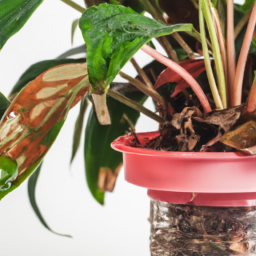
Indoor Plant Troubleshooting: Common Problems and Solutions
3. Dealing with Common Pest Infestations in Indoor Plants: Troubleshooting Guide
Indoor plants are a great way to bring nature into your home, but sometimes they can become susceptible to pest infestations. Dealing with these pesky intruders can be frustrating, but with the right knowledge and approach, you can effectively troubleshoot and solve the problem. In this guide, we will explore some common pest infestations in indoor plants and provide step-by-step solutions to overcome them.
1. Identifying Common Indoor Plant Pests
Before we delve into the solutions, it’s important to be able to identify the common pests that may infest your indoor plants. Here are some of the most common ones:
Aphids: These small, soft-bodied insects can be found on the undersides of leaves and are usually green or black in color. They suck sap from plants and can cause leaves to curl or become distorted.
Spider Mites: These tiny pests are difficult to see with the naked eye but can be identified by the fine webbing they produce on plants. They feed on plant fluids and can cause yellowing or stippling of leaves.
Fungus Gnats: These small, dark-colored flies are often found around moist soil. Their larvae feed on plant roots, leading to stunted growth and yellowing of leaves.
Mealybugs: Mealybugs are small, white, cotton-like insects that cluster on stems and leaf joints. They suck plant sap and can cause wilting and yellowing of leaves.
Scale Insects: These insects appear as small, round bumps on plant stems and leaves. They suck sap from plants and can cause yellowing, wilting, and leaf drop.
2. Prevention and Early Detection
The best way to deal with pest infestations is to prevent them from occurring in the first place. Here are some preventive measures you can take:
Regularly inspect your plants: Regularly check your indoor plants for any signs of pests or damage. Early detection can help prevent infestations from spreading.
Quarantine new plants: When bringing new plants into your home, keep them separate from your existing plants for a few weeks to ensure they are pest-free.
Maintain proper plant hygiene: Cleanliness is key to preventing pest infestations. Remove dead leaves, debris, and any fallen plant material from the soil surface.
Avoid overwatering: Overwatering can create a favorable environment for pests. Make sure to water your plants only when the top inch of soil feels dry.
3. Treatment and Control
If you have identified a pest infestation in your indoor plants, here are some steps you can take to treat and control the problem:
Isolate the affected plant: Move the infested plant away from other plants to prevent the pests from spreading.
Manual removal: For larger pests like mealybugs or scale insects, you can manually remove them using a cotton swab dipped in rubbing alcohol.
Pruning: If the infestation is severe, consider pruning heavily infested areas or even removing the entire plant if necessary.
Natural remedies: There are several natural remedies you can try, such as neem oil, insecticidal soap, or a mixture of water and dish soap. Be sure to follow the instructions on the product label.
Biological control: Introducing beneficial insects like ladybugs or predatory mites can help control certain pest populations.
Chemical control: As a last resort, chemical insecticides can be used. However, exercise caution and follow the instructions carefully to avoid harming your plants or yourself.
By following these steps and staying vigilant, you can effectively troubleshoot and solve common pest infestations in your indoor plants. Remember, prevention is key, so always maintain good plant hygiene and regularly inspect your plants to catch any issues early on. Happy gardening!
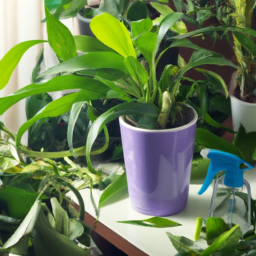
Overcoming Nutrient Deficiencies in Indoor Plants: Common Problems and Solutions
Welcome to our comprehensive guide on overcoming nutrient deficiencies in indoor plants. Indoor gardening can be a rewarding and fulfilling experience, but sometimes our plants may encounter problems due to nutrient deficiencies. In this article, we will explore the common problems faced by indoor plants and provide step-by-step solutions to help you maintain healthy and thriving greenery in your home.
Identifying Nutrient Deficiencies
Before we dive into the solutions, it is crucial to identify the signs of nutrient deficiencies in your indoor plants. By understanding the symptoms, you can accurately diagnose the problem and take appropriate action. Here are some common signs to look out for:
1. Yellowing Leaves: If your plant’s leaves are turning yellow, it could indicate a deficiency in essential nutrients like nitrogen, iron, or magnesium.
2. Stunted Growth: Lack of proper nutrition can lead to stunted growth. If your plants are not growing as expected or appear smaller than usual, nutrient deficiencies might be the culprit.
3. Leaf Discoloration: Discoloration, such as brown spots or pale leaves, can point towards deficiencies in specific nutrients like phosphorus, potassium, or calcium.
Solution: Understanding Nutrient Requirements
Now that we have identified the symptoms, let’s delve into the solutions. The first step is to understand the nutrient requirements of indoor plants. Each plant has unique needs, and providing the right balance of nutrients is essential for their optimal growth. Here are the key nutrients and their functions:
1. Nitrogen (N): Nitrogen is crucial for leaf and stem development. It promotes lush, green foliage and helps plants produce proteins necessary for growth.
2. Phosphorus (P): Phosphorus aids in root development, flowering, and fruiting. It plays a vital role in energy transfer and overall plant metabolism.
3. Potassium (K): Potassium is essential for overall plant health. It strengthens the immune system, enhances water and nutrient uptake, and improves resistance to diseases and pests.
4. Iron (Fe): Iron is necessary for chlorophyll production, which is responsible for the green color in plants. It also aids in photosynthesis and overall plant vitality.
Solution: Correcting Nutrient Deficiencies
Now that we have a basic understanding of the essential nutrients, let’s explore the solutions to overcome nutrient deficiencies in indoor plants:
1. Soil Testing: Conduct a soil test to identify the specific nutrient deficiencies. Soil testing kits are readily available and provide accurate results. Once you determine the lacking nutrients, you can take targeted action.
2. Fertilization: Use a balanced fertilizer specifically formulated for indoor plants. Choose a fertilizer with a nutrient ratio appropriate for your plant species and follow the recommended application instructions. Regular fertilization helps replenish the nutrients in the soil.
3. Organic Amendments: Incorporate organic amendments like compost or well-rotted manure into the soil. These natural sources of nutrients enhance soil fertility and provide a slow-release supply of essential elements.
4. Foliar Feeding: In severe cases of nutrient deficiencies, foliar feeding can be an effective solution. Spray a diluted nutrient solution directly onto the leaves, allowing them to absorb the nutrients quickly.
5. Adjusting pH: Nutrient availability is influenced by soil pH. Some nutrients are more accessible at specific pH levels. Test the pH of your soil and adjust it accordingly using pH modifiers to ensure optimal nutrient uptake.
6. Controlled Release Fertilizers: Consider using controlled-release fertilizers that gradually release nutrients over an extended period. These fertilizers provide a steady supply of nutrients, reducing the risk of over-fertilization or nutrient imbalances.
7. Regular Watering: Proper watering practices are essential for nutrient uptake. Avoid overwatering or underwatering, as both can negatively impact nutrient absorption. Maintain a consistent watering schedule based on your plant’s specific needs.
8. Monitoring and Maintenance: Regularly monitor your plants for any signs of nutrient deficiencies. Adjust your care routine as needed, ensuring that your indoor plants receive adequate light, proper ventilation, and the right amount of nutrients.
By following these solutions, you can overcome nutrient deficiencies in your indoor plants and promote healthy growth. Remember to provide a nurturing environment, observe your plants closely, and make adjustments accordingly. With proper care and attention, your indoor plants will thrive and bring beauty to your living space.
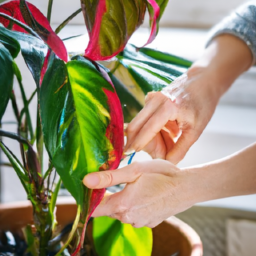
Preventing and Treating Fungal Diseases in Indoor Plants: Troubleshooting Tips
Indoor plants can bring life and beauty to any space, but they are not immune to certain problems, including fungal diseases. Fungal diseases can quickly spread and harm your beloved plants if left untreated. In this guide, we will provide you with step-by-step tips to prevent and treat fungal diseases in indoor plants, ensuring their health and longevity.
Understanding Fungal Diseases
Fungal diseases are caused by various types of fungi that thrive in warm, humid environments. Indoor plants can be particularly susceptible to fungal infections due to the controlled environment they are kept in. Common fungal diseases in indoor plants include powdery mildew, leaf spot, and root rot.
To prevent and treat fungal diseases effectively, it is crucial to understand the signs and symptoms associated with each type of infection. This will enable you to take prompt action and implement appropriate solutions.
Powdery Mildew: Powdery mildew appears as a white, powdery substance on the leaves and stems of plants. It can cause stunted growth and eventually lead to leaf drop. This fungal disease thrives in high humidity and moderate temperatures.
Leaf Spot: Leaf spot is characterized by dark, water-soaked spots on the leaves of plants. These spots may vary in size and color, depending on the specific fungal species. Leaf spot can weaken the plant and make it more susceptible to other infections.
Root Rot: Root rot affects the roots of plants and is often caused by overwatering or poorly draining soil. Infected roots become mushy, discolored, and may emit a foul odor. As the disease progresses, the plant may wilt, and the leaves may turn yellow or brown.
Preventing Fungal Diseases
Prevention is key when it comes to fungal diseases in indoor plants. By following these preventive measures, you can significantly reduce the risk of your plants falling victim to these infections:
1. Proper Air Circulation: Ensure adequate air circulation around your indoor plants. This can be achieved by placing them in well-ventilated areas or using fans to improve air movement. Good air circulation helps to reduce humidity levels, making it less favorable for fungal growth.
2. Avoid Overwatering: Overwatering creates a damp environment that fungi thrive in. Water your plants only when the top inch of soil feels dry to the touch. Additionally, make sure your pots have proper drainage holes to prevent water from accumulating at the bottom.
3. Maintain Optimal Humidity: Most indoor plants prefer moderate humidity levels. Avoid excessively humid conditions by using a dehumidifier or placing a tray of water near your plants to increase humidity when needed. Monitoring and maintaining the right humidity levels can help prevent fungal diseases.
4. Cleanliness and Hygiene: Regularly clean your indoor plant’s leaves and remove any fallen debris or dead plant material from the soil surface. This reduces the chances of fungal spores finding a suitable environment to grow and infect your plants.
5. Quarantine New Plants: Before introducing a new plant to your indoor garden, quarantine it for a few weeks to ensure it is free from any fungal infections. This prevents the spread of diseases to your existing healthy plants.
Treating Fungal Diseases
If despite your best efforts, your indoor plants become infected with a fungal disease, it is essential to take immediate action to prevent further damage. Here are steps to effectively treat fungal diseases:
1. Identify the Disease: Carefully examine the affected plant to identify the specific fungal disease. Look for characteristic symptoms such as powdery white substance (powdery mildew), dark spots on leaves (leaf spot), or rotting roots (root rot).
2. Isolate the Infected Plant: Remove the infected plant from its current location and isolate it from other healthy plants. This prevents the disease from spreading and infecting the entire collection.
3. Prune and Dispose of Infected Parts: Trim off the infected leaves, stems, or roots using sterilized pruning tools. Dispose of the infected plant material in sealed bags to prevent the spread of fungal spores.
4. Adjust Environmental Conditions: Create unfavorable conditions for fungal growth. Reduce humidity levels, increase air circulation, and ensure proper ventilation. This will help inhibit further spread of the disease and aid in the plant’s recovery.
5. Apply Fungicides: In severe cases, where the fungal infection persists despite preventive measures, you may consider using fungicides. Choose a fungicide specifically formulated for indoor plants and follow the instructions carefully. Apply the fungicide as directed, ensuring thorough coverage of all plant surfaces.
6. Monitor and Maintain: After treatment, closely monitor your plants for any signs of recurring infections. Continue practicing preventive measures to maintain a healthy environment for your indoor plants.
By following these preventive measures and taking prompt action when fungal diseases occur, you can keep your indoor plants thriving and free from harmful infections. Remember, early detection and intervention are vital for successful treatment. Enjoy the beauty and benefits of indoor plants while keeping them healthy and disease-free!
Frequently Asked Questions (FAQ)
Indoor Plant Troubleshooting: Common Problems and Solutions
1. Why are my indoor plants turning yellow?
Yellowing of leaves can be caused by overwatering, nutrient deficiencies, or inadequate sunlight. Adjusting watering habits, providing proper nutrition, and ensuring adequate light levels can help resolve this issue.
2. How do I prevent pests from infesting my indoor plants?
To prevent pests, regularly inspect your plants for signs of infestation, maintain good hygiene by removing dead leaves and debris, and consider using organic pest control methods like neem oil or insecticidal soap.
3. What should I do if my indoor plant is wilting?
Wilting can occur due to underwatering, overwatering, or root problems. Check the moisture level of the soil, adjust your watering routine accordingly, and examine the roots for any signs of rot or damage.
4. How often should I water my indoor plants?
The watering frequency depends on various factors such as plant type, pot size, humidity levels, and environmental conditions. As a general guideline, it’s best to water when the top inch of soil feels dry.
5. What are some signs of overwatering?
Signs of overwatering include yellowing leaves, wilting, root rot, and the presence of fungus gnats. It’s important to allow the soil to dry out between watering sessions to avoid overwatering.
6. How can I increase humidity for my indoor plants?
You can increase humidity by using a humidifier, placing a tray of water near the plants, grouping plants together, or misting them regularly. Another option is to create a pebble tray by filling a tray with water and placing the pots on top of the pebbles.
7. What is the best way to fertilize indoor plants?
Indoor plants can be fertilized using liquid or granular fertilizers specifically formulated for houseplants. Follow the instructions on the fertilizer packaging for proper application and frequency.
8. How do I know if my indoor plant needs repotting?
If the roots are visibly growing out of the drainage holes, the plant is top-heavy and prone to tipping over, or the soil dries out very quickly after watering, it may be time to repot your indoor plant into a larger container.
9. Can I save my indoor plant if it has yellow leaves with brown spots?
Yellow leaves with brown spots can indicate a fungal or bacterial infection. It’s best to isolate the affected plant, remove the affected leaves, and treat it with a suitable fungicide or bactericide to prevent further spread.
10. How can I encourage my indoor plants to bloom?
To encourage blooming, make sure your plants are receiving adequate sunlight, provide them with the appropriate amount of water and fertilizer, and ensure they are in the right temperature range. Some plants may also require a period of dormancy or specific light conditions to initiate blooming.
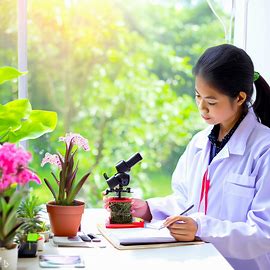
Lisa Chen is a seasoned indoor gardening expert and the author of several bestselling books on the topic. With a background in horticulture and urban farming, Lisa is dedicated to helping urban dwellers embrace the joys of cultivating green spaces indoors. Her detailed guides and hands-on tips empower readers to transform their living spaces into thriving plant sanctuaries.

